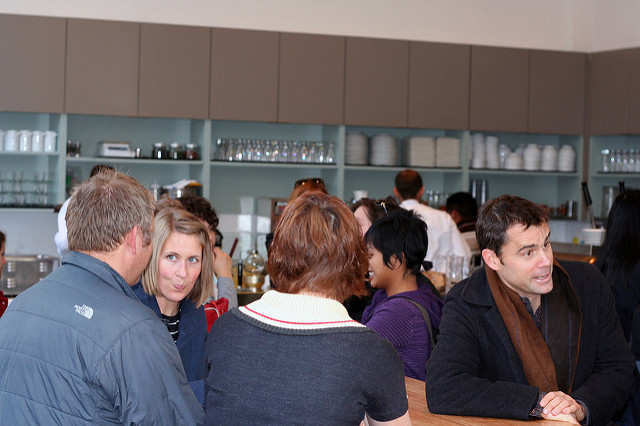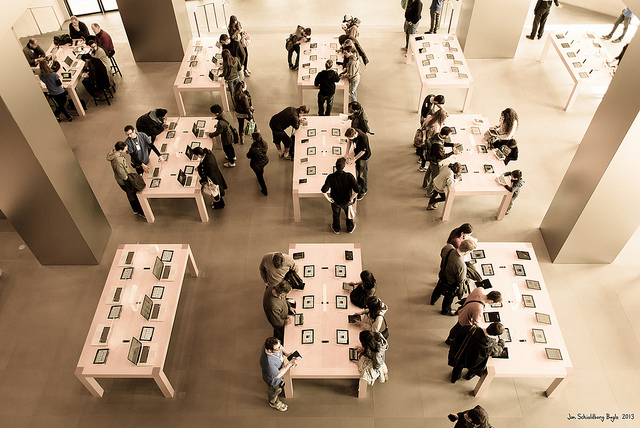Unlock the Magic in Your Story Now
Get the Free 20 questions to Ask Before Launching Your Idea workbook when you sign up for occasional updates.
Get the Free 20 questions to Ask Before Launching Your Idea workbook when you sign up for occasional updates.
Articles filed in: Strategy
The Power Of Promises
 “You’ll have it by Friday.”
“You’ll have it by Friday.”
“I’ll call you tomorrow.”
“We’ll be there by 3pm.”
How many times have promises like these been made to you in the past few weeks, only to be casually broken and replaced by a fresh set soon after?
Doing what you say you’ll do is the fastest route to building credibility, trust, and loyalty.
The ability to keep the promises you make is your new competitive advantage.
Grow Your Business By Watching What People Do
filed in Marketing, Storytelling, Strategy
 I once walked the length for Bourke Street behind a young man in a hurry heading towards Southern Cross Station. His backpack was slung over one shoulder and a designer shopping bag in the other hand bumped his knee as he walked revealing the Christian Louboutin logo. When we both stopped at the lights I couldn’t resist asking him what he’d bought. The shoes, he told me were a gift for a girlfriend he was trying to “win back”. The gesture had to be unforgettable.
I once walked the length for Bourke Street behind a young man in a hurry heading towards Southern Cross Station. His backpack was slung over one shoulder and a designer shopping bag in the other hand bumped his knee as he walked revealing the Christian Louboutin logo. When we both stopped at the lights I couldn’t resist asking him what he’d bought. The shoes, he told me were a gift for a girlfriend he was trying to “win back”. The gesture had to be unforgettable.
Christian Louboutin is one of the most successful shoe designers in the world, selling more than half a million pairs of shoes a year. A pair of Louboutin’s will set you back between $395 and $6,000, their distinctive red soles are a marketing coup.
The root of the designer’s success is twofold. Firstly he knows who his customer is, and importantly who she is not, he doesn’t make shoes for “women who play bridge in the afternoon”. Secondly, he watches what she does and understands the role of his product in shaping her perception of herself.
Louboutin once said, “When a woman buys a pair of shoes, she never looks at the shoe. She stands up and looks in the mirror, she looks at the breast, the ass, from the front, from the side, blah blah blah. If she likes herself, then she considers the shoe.”
The opportunity to go deeper and gain valuable insights into our customers behaviour is open to each and every business. Those insights we observe can transform innovation, service and marketing.
How much time are you devoting to understanding how your customer’s actions drive their buying decisions?
Image by Adrain Scottow
What Do Your Customers Really Want?
filed in Marketing, Storytelling, Strategy
 There’s an Italian Cafe in our neighbourhood serving good coffee and speciality cakes. It’s jam-packed every single evening—not because people are hungry for cake, but because they are hungry for the feeling of being connected. They seek out the place that makes them feel that way.
There’s an Italian Cafe in our neighbourhood serving good coffee and speciality cakes. It’s jam-packed every single evening—not because people are hungry for cake, but because they are hungry for the feeling of being connected. They seek out the place that makes them feel that way.
Howard Schultz recognised the power of people’s aspirations thirty years ago, when he transformed Starbucks from a coffee roaster into ‘the third place’ by grounding the brand’s value proposition in a story about ritual and community.
Just as a successful cafe isn’t ever just about the coffee, the products and services you sell create meaning for your customers beyond their utility. The truth is that as marketers, we often miss the opportunity to acknowledge and reflect that story back to them.
Does your story align with the story your customers really want to believe?
Image by Niall Kennedy.
The Cost Of Interruption
 The web design firm can access thousands of contact details for newly registered domains each day. It’s easy from there to hire a bunch of poorly trained phone operatives (who are overqualified to do soulless work but need the money) to interrupt people.
The web design firm can access thousands of contact details for newly registered domains each day. It’s easy from there to hire a bunch of poorly trained phone operatives (who are overqualified to do soulless work but need the money) to interrupt people.
It’s possible to scrape, buy, trawl and interrupt a thousand people for next to nothing. What are we losing the opportunity to work on doing better by reaching for the lowest hanging fruit?
We count the cost of converting a prospect to a customer.
We rarely count the cost of treating people like ‘prospects’.
Image by Sullivan Gardner.
The Importance Of A Responsive Business Mindset
 The beauty salon owner has a limited number of available appointments. Every day she encounters the same problem—zero availability and several last minute cancellations or no-shows. This situation is frustrating and it’s losing her money. She thinks she might solve the problem by implementing a cancellation fee, charging clients who cancel within 24 hours of their appointment, but she knows that this move could alienate her customers.
The beauty salon owner has a limited number of available appointments. Every day she encounters the same problem—zero availability and several last minute cancellations or no-shows. This situation is frustrating and it’s losing her money. She thinks she might solve the problem by implementing a cancellation fee, charging clients who cancel within 24 hours of their appointment, but she knows that this move could alienate her customers.
When you encounter a problem it’s natural to be reactive. That’s useful in some situations—if a bucket is leaking water the obvious solution is to plug the hole. The reactive solution comes from questioning how to stop something happening.
But the reactive approach doesn’t always serve us long term. Far better to adopt a responsive business mindset that prompts us to dig deeper and uncover what’s causing the problem. Questioning why something is happening and how we might change the situation will deliver far more creative solutions than shooting from the hip ever will.
The quick fix isn’t always the right one.
Image by Thomas Leuthard.
The Sustainable Marketing Strategy
filed in Marketing, Storytelling, Strategy
 The fast food restaurant’s latest advertising campaign announces the return of it’s famous $1 chips. Of course, the lure of the bargain will bring back people who have forgotten that this brand exists. Foot traffic will increase and revenue along with it—for a little while.
The fast food restaurant’s latest advertising campaign announces the return of it’s famous $1 chips. Of course, the lure of the bargain will bring back people who have forgotten that this brand exists. Foot traffic will increase and revenue along with it—for a little while.
The local organic store puts out platters of delicious free samples for customers to try every lunchtime. The staff take time to answer questions about products, ingredients, and food allergies. Customers browse and linger. Revenue increases are reliable and sustained.
We have two choices. We can work hard to get attention and try to influence the customer’s short-term purchasing decisions, or we can set out to understand the context around what motivates him to want to belong first and buy later.
Which strategy are you working on?
Image by Jeffrey Smith.
The Power Of Relevance
 I recently got an email about an online service I’d once signed up for.
I recently got an email about an online service I’d once signed up for.
The email detailed new product features. There was also a call to action.
“It’s been 3.2 Years since you updated your profile.”
This was the first time I’d heard from the company in over three years. I’d never once engaged with them or their platform in all that time and they knew it too.
We have more big and small data about our customers than ever before. Leveraging it to stay relevant to those customers is the greatest marketing shortcut there is.
How are you using your understanding of your customers to sustain your relationship with them?
Image by Quinn Dromboski
 The purpose of your brand story and of every piece of marketing material is to move a prospective customer from awareness to loyalty.
The purpose of your brand story and of every piece of marketing material is to move a prospective customer from awareness to loyalty. Ira’s cafe is tucked away at the bottom of a narrow city centre laneway. Without regulars who live close by Ira’s place is dependent on converting tourists and weekend shoppers into diners. Every neighbouring cafe stations a host in the small doorway waiting for passers-by to make a decision. Ira takes up his post in the cafe doorway too, but he approaches the problem a little differently.
Ira’s cafe is tucked away at the bottom of a narrow city centre laneway. Without regulars who live close by Ira’s place is dependent on converting tourists and weekend shoppers into diners. Every neighbouring cafe stations a host in the small doorway waiting for passers-by to make a decision. Ira takes up his post in the cafe doorway too, but he approaches the problem a little differently. Most brand stories…
Most brand stories…